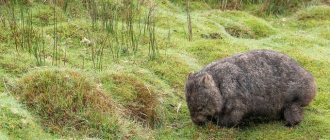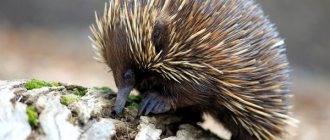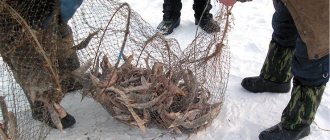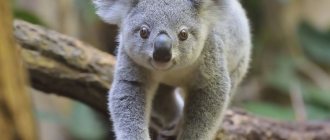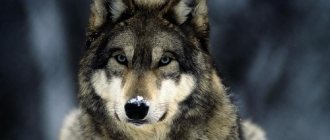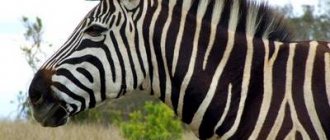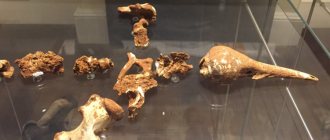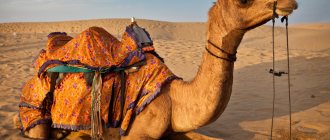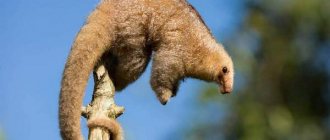The wombat is a medium-sized marsupial herbivore mammal from the two-incisor order. Lives exclusively in Australia. Outwardly it resembles a bear cub or a large hamster, and also looks like a koala. Known as the square-poo animal because wombats defecate in cubes.
Description and origin of the species
Wombats diverged from other Australian marsupials relatively early, approximately 40-25 million years ago. Early studies considered the animal to be a miniature descendant of Diprotodon, a giant rhinoceros-sized wombat that lived in Australia during the Pleistocene era. Modern research has disproved this theory, showing that the wombat and diprotodon lineages evolved in parallel. The wombat's closest living relatives are koalas.
British explorers discovered the wombat as a new species in 1797. The name "wombat" was borrowed from the language of the Darug Aboriginal people who lived in what is now Sydney in 1798. Early settlers often called the animal a badger due to its similar size and burrowing habit.
The wombat builds underground shelters for himself, where he invites his buddies
Pukhlyan digs holes with incredible speed. He is a real god of digging and when applying for a job in the “your advantages” column he always writes “digging holes.” This beast makes entire labyrinths, some so spacious that a person can fit in them. The wombat not only creates intricate passages, it is just waiting for the predator to climb into them and get what it deserves.
Sometimes the wombat allows his buddies to stay at his house. But when they finally get him, he might kick him out. At the same time, he growls and shouts that they are no longer his friends. But then everyone makes peace.
The largest copper deposit in Australia was dug up by a wombat, not a human. People simply climbed into a hole (these were the most desperate Australians in history) and discovered metal deposits there. Wombats are smart creatures; give them a couple of thousand years, and they would probably learn how to smelt copper and make weapons. But we were ahead of them. We were lucky.
What does a wombat look like?
Externally, a wombat looks like a small bear or a large badger, and also has similar features to a koala. The animal has a massive, stocky body and short powerful legs with long claws. The head is large, slightly flattened on the sides. Small eyes, small round ears. The common wombat has a bare nose, while the other two species have a furred nose.
The body length is about 1 meter, the weight of the animal is from 20 to 35 kg. Color ranges from sandy yellow to dark brown, and gray and black animals are also found. The structure of the teeth is very similar to the teeth of rodents - a pair of front incisors above and below, and powerful chewing teeth for chewing grass.
Types of wombats
The wombat family consists of 3 species that have survived to this day. 3 species are combined into 2 genera - woolly-nosed and bare-nosed wombats.
- common wombat ( Vombatus ursinus
). Also known as the shorthair, barenose or Tasmanian. - northern woolly-nosed wombat ( Lasiorhinus krefftii
). It is also called yaminon, or Queensland. - southern woolly-nosed wombat ( Lasiorhinus latifrons
). Another name is broad-fronted wombat.
Wombats are very different. Some look like drunken mutant rodents, and some look like bears
There are actually two kinds of wombats: long-haired and short-haired. Longhairs look like tipsy mutant rodents. Short-haired ones look like dwarf bears. Considering that a wombat can grow to almost half a meter in length, it is indeed easy to confuse them.
If you want to take a wombat (or wombat) on a date to a restaurant, order a dish of grass, mushrooms and reeds. Season everything with grated bark and watch the bastard bite both cheeks. He doesn’t eat any other food, although he is offended by the term “vegan”.
Where does the wombat live?
The animals live in wooded, mountainous and heather areas in eastern and southern Australia, including Tasmania, and in Epping Forest National Park in central Queensland. The wombat adapts well to a variety of natural conditions, but requires soil suitable for digging burrows.
Common wombats are widespread in cooler, well-watered parts of southern and eastern Australia, including Tasmania, and in mountainous areas as far south as Queensland. But their numbers in Victoria and South Australia are declining. The habitat is tropical, eucalyptus and common forests, alpine meadows and coastal zones. The animals have adapted to agriculture and can live in the same fields as livestock.
Northern woolly-nosed wombats are critically endangered and survive only in the closed Epping National Park in central Queensland. Just 100 years ago, their habitat extended across the states of New South Wales, Victoria and Queensland.
Southern woolly-nosed wombats are found in Western Australia, South Australia and New South Wales. As a habitat, animals prefer arid and semi-arid forests and meadows.
Habitat
Wombats (Vombatidae) are a family of marsupial mammals from the order Diprotodontia. These animals are close relatives of koalas - in ancient times they had common ancestors, one of which reached the size of a hippopotamus. But once upon a time, the paths of the koala and the wombat diverged: the first found refuge in the trees, and the second began to dig deep holes.
Wombats live only in Australia - in the southeast of the continent, as well as on the Tasmania and Flinders Islands. A characteristic feature of animals is the ability to maintain high population densities even in unproductive areas.
In sandy coastal areas, the population of short-haired wombats reaches very high densities. They can also be found in the alpine belt up to the snow line and above.
Long-haired wombats favor dry regions where soil fertility is too low to support livestock, but these marsupials thrive here.
What does a wombat eat?
The wombat is a herbivore; the animal eats young grass, sedge, plant roots and tree bark. The animal has a very slow metabolism - it takes about 14 days to completely digest food.
Animals rank second in the world after camels in terms of minimal water consumption. The animal only needs 22 ml of water per 1 kg of live weight per day. This is 4 times less than what a kangaroo needs. In Australia's dry, hot climate, low water consumption is a significant advantage.
Nutrition
The food source for wombats is vegetation. They consume grass shoots, roots of some plants, and can feed on moss, as well as berries and mushrooms.
And they identify edible vegetation using the upper lip, divided into two parts.
Large front teeth protrude from under it, with which animals easily cut off young shoots to the very root.
Thanks to a well-developed sense of smell, these representatives of the fauna have excellent orientation even at night.
Wombats find food without much difficulty, even despite poor eyesight
Interesting! Wombats have a slow but very efficient metabolism. After saturation, the animal’s body needs about 2 weeks to digest the incoming food!
Character and lifestyle
Wombats dig vast burrows underground using powerful claws and rodent-like front teeth. The length of underground tunnels can reach 30 meters and go to a depth of 3.5 meters. The animal's pouch is located at the back so that when digging, the earth does not fall into the pouch and onto the baby. The animals emerge from their burrows mainly at dusk and at night, occasionally emerging during the day on a cold or foggy day.
Animals have good hearing and an excellent sense of smell, but have poor vision. Males always lead a solitary lifestyle. Females can share a burrow with other females, but prefer not to meet with their relatives on the surface.
Each animal has its own territory, which the animal actively defends from competitors. The common wombat occupies an area of up to 23 hectares. Woolly-nosed wombats have much smaller territories, up to 4 hectares. If another animal violates the territory, the wombat shakes its head from side to side and moos. Wombats usually move rather slowly, but in case of danger, they are capable of short-term sprinting and reach speeds of up to 40 km/h over a distance of up to 150 meters.
The animals are generally quite quiet, but during the mating season they become more active and attract vocal partners. Interestingly, bare-nosed wombats make more different sounds than woolly-nosed wombats. An angry wombat hisses threateningly, and the animal's calling cry is more reminiscent of a pig's squeal. The animals also make grunting sounds, low growls, hoarse coughs and clicking sounds.
Square wombat poop
Wombats are the only animals that defecate in cubes. Why are these animals' excrement square-shaped? Because animals use their feces to attract mates and to mark their territory, cube-shaped feces provide a biological advantage. The cubes are easier to stack and less likely to roll, slide, or fall apart.
The exact mechanism of how the animal manages to produce square poop is not fully known. Scientists suggest that the reason is in the special structure of the digestive system. The wombat's intestines contract only on two sides, the other 2 sides remain motionless. The animal produces from 80 to 100 cubes of feces in one night, and from 4 to 8 pieces at a time.
The wombat has cubes of shit - because he is very economical
The most famous fact about the wombat is that it leaves behind cubes of feces. But few people know why and what the point is. The fact is that the wombat has a specific intestine - it has horizontal partitions, due to which the animal leaves precisely the cubes.
The cool thing is that this shape does not allow them to roll off the surface of stones or roots, and insects cannot roll away such feces. Why is all this? The wombat uses them to mark its territory, and it is important for it that the marks remain where they are supposed to be for a long time. Because there must be order in the forest!
Reproduction and young
The mating season for wombats lasts all year round. Animals stop reproducing only during periods of drought. Only one baby is always born in a litter. The female's pouch is always turned back to prevent soil from getting into it when digging.
Pregnancy lasts about 20-30 days, depending on the species. The baby leaves its mother's pouch only at the age of 6-7 months, and remains nearby for the next year. The mother feeds the baby with breast milk for up to 15 months. At the age of 1.5-2 years, animals reach sexual maturity.
Caring mothers
Like all marsupials, the only wombat cub is born premature. However, the baby's well-developed forelimbs help him move into his mother's pouch, where he remains for 6-8 months. Since the hole in the pouch is located on the back, the baby is reliably protected from soil when the mother digs holes.
It is worth noting that female wombats are very responsible and caring mothers. Even when the baby has grown a little and can get out of the bag on his own, he is constantly in the mother’s field of view. As a rule, a small wombat lives with its mother for up to 1 year.
As is the case with most of Australia's nocturnal animals, warning signs are posted on highways in wombat habitats.
Natural enemies
In the wild, the wombat is hunted by wild dogs, dingoes and Tasmanian devils. Previously, they were also hunted by now extinct predators - marsupial lions and thylacines.
The wombat's main defense mechanism against predators is their strong loin. The back of the animal's body consists of cartilage, thick skin and reinforced bones, so it is very strong and represents a kind of shield. There is either no tail, or it is not at all important to the animal. At the moment of danger, the wombat rushes into the nearest hole and blocks the passage of the predator with its back part of the body.
The animal often leaves a place at the top of the hole for the predator to stick its head or paw into, and then tries to crush the head or limbs of the attacker against the ceiling and walls of the tunnel. The wombat has short but powerful and muscular legs, so it kicks well with its hind legs, like a donkey. The animal is also good at butting its head, like a ram or a goat. If a predator nevertheless climbs into its hole, the wombat tries to corner it and strangle it with its “shield”.
Wombat growls and farts when angry
The wombat is not a very noisy animal. You know, he's the kind of guy who comes to a bar and doesn't take part in the fun, just sits in the corner on his fat ass and stares at everyone with his button eyes.
- The wombat lets out gases angrily.
But you shouldn’t anger the wombat - when this pot-bellied guy is not in the mood, he starts growling, and if he’s really angry, he can defiantly and very noisily spoil the air. This, by the way, is not due to intestinal problems, but due to evolution. This is how a wombat defends its burrows when they are attacked - it blows gases right into the attacker’s face, which stings the eyes.
Population and protection of the species
Wombats of all species are protected by the Australian government.
- The northern woolly-nosed wombat is listed in the International Red Book and has the status of a species on the verge of complete destruction. In 2003, there were 113 individuals of this species remaining in the world, of which no more than 30 were females. To date, the animal population has doubled.
- The southern woolly-nosed wombat is classified as a vulnerable species.
- The common wombat is listed in the Red Book with the status of a species not causing concern.
European colonization of the continent caused significant damage to the population. According to experts, before the colonization of Australia by Europeans, the habitat of animals was 10 times larger. In addition, back at the beginning of the 20th century, the animal was considered a harmful animal. In 1925, hunters were given a reward for his murder.
The main threats to the population today:
- reduction of natural habitat;
- illness;
- hunting by wild dingo dogs;
- severe competition for food supply from livestock.
